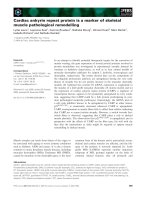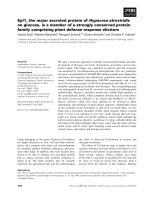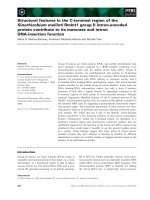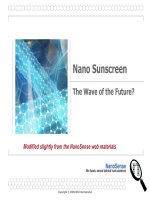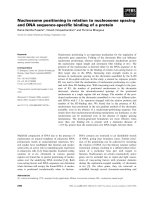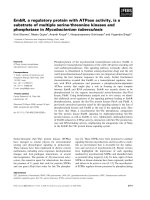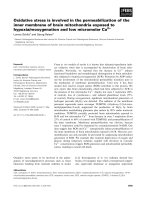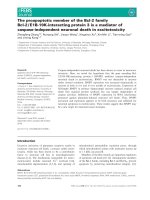The research is a sure-fire solution to apply on realistic condition due to its feasibility and low cost for a development of sustainable agriculture in Vietnam as the top aims of Sony Green competition
Bạn đang xem bản rút gọn của tài liệu. Xem và tải ngay bản đầy đủ của tài liệu tại đây (264.91 KB, 16 trang )
CHAPTER 1: INTRODUCTION
-------o0o------
Breeding as one of the major sections of agriculture is playing a vital role in
Vietnam including the Mekong Delta. However, waste of breeding activity has not
been treated well. It is one of the most important reasons which cause pollution of
river resources.
In order to cope with these challenges, human must have experimental
science to find the way to improve the environment, research to apply waste
treatment of aquatic plant with their bio-filter capability.
Ludwigia (Jussiaea repens L.) is one of aquatic plants which normally
develop at riverbank, in particular in polluted environment. Ludwigia has a great
potential in waste treatment which is unfortunately not researched carefully.
Due to this reason, this study is performed with the purpose of diving deeply
in researching Ludwigia’s capability in waste treatment. The research is a sure-fire
solution to apply on realistic condition due to its feasibility and low cost for a
development of sustainable agriculture in Vietnam as the top aims of Sony Green
competition.
Vu Thuy Quang – Nguyen Minh Thu
1
CHAPTER 2: TREATMENT WASTE WATER IN BREEDING
BY AQUATIC PLANT
-----o0o----2.1. Classification aquatic plant:
2.1.1. Aquatic plant live sink:
2.1.2. Aquatic plant live drift:
2.1.3. Aquatic plant live float:
Table: Some of aquatic plants popular
Type
Aquatic plant
live sink
Scientific name
Hydrilla verticillata
Myriophyllum spicatum
Blyxa aubertii
Eichhornia crassipes
Aquatic plant
Wolfia arrhiga
live drift
Pistia stratiotes
Salvinia spp
Typha spp
Aquatic plant
Scirpus spp
live float
Phragmites communis
Jussiaea repens L.
2.2. Some of aquatic plants in Mekong delta
- Aquatic plant live drift:
Figure: Water hyacinth
Vu Thuy Quang – Nguyen Minh Thu
2
- Aquatic plant live float
Figure: Seed
2.3. Composition of the body in an aquatic plant:
- Content of water
- Content of protein
2.4. Biological treatment:
2.4.1. Use pond for treatment waste water:
2.4.2. Waste treatment by aquatic plant:
Table: Part of aquatic plants in a system of treatment waste water
Plant
-Root or body
Object
-Bracket for bacterium to develop
-Filtration and absorption nutriment
-Body or leafs on water surface
-Absorbing daylight and so preventing
or over surface
excessive development of alga.
-Decreasing influence of air on the waste
surface.
-Decreasing exchange between waste and
air around.
-Transferring oxygen from leafs to root
Vu Thuy Quang – Nguyen Minh Thu
3
CHAPTER 3: OBJECT STUDY
LUDWIGIA – JUSSIAEA REPENS L.
AND CHARACTERISTICS OF WASTE WATER IN BREEDING
-----o0o----3.1. Object study Ludwigia – Jussiaea repens L.
- Scientific name is Jussiaea repens L. (family name
OENOTHRERACEAE), normal name is Ludwigia.
- Stature: weed, rise over surface by white float-root and
knotty tree.
- Leafs: simple leaf, 2 type of broad leafs; upper-leaf
and under-leaf.
- Flower: ivory-white flower, blade 1cm, petal, hairy-overy,
triangle-carpel.
- Habitation: rise into the fields, humidity 0 - 1000m in Viet
Nam, blossom from June to September
Figure: Ludwigia with white float-root
Vu Thuy Quang – Nguyen Minh Thu
4
3.2. Characteristics of waste water in breeding:
Table: Some of chemical-physical index in waste water
Value
Index
Unit
Temperature
pH
COD
BOD5
0
C
mg/l
mg/l
Before deposit
After deposit
26-30
6,5 - 7,8
5000-6000
3000-4000
26-30
6 - 7,8
500-860
300-530
COD: Chemical oxygen demand;
BOD: Biochemical oxygen demand, measured over 5 day at 20oC.
3.3. Structure of waste treatment by aquatic plant – Ludwigia
3.3.1. Structure disposes of BOD:
Figure: Relation symbiosis between
Aquatic plant (AP) and Micro-organism (MO).
AP
(1)
MO
(2)
Disintegrate
organic
New substance is easy
for absorbtion and
transformation
(1) Bracket for micro-organism develops.
(2) Supply oxygen for micro-organism that disintegrate aerobic organic.
3.3.2. Structure disposes of Phosphate:
3.3.3. Structure disposes of Bacterium:
3.3.4. Structure disposes of heavy metal:
3.3.5. Structure decrease a phenomenon “alga bloom”
Vu Thuy Quang – Nguyen Minh Thu
5
CHAPTER 4: OBJECTIVE - METHOD OF STUDY
-------o0o-----4.1. Objective research
- General objectives: Improving the quantity of waste water in breeding to
protect environment and develop sustainability in agriculture.
- Concrete objectives:
+ Investigate some chemical-physical index in waste water with Ludwigia.
+ Investigate a growing capability of Ludwigia in waste water and pure
water.
+ Comparison and conclusion about Ludwigia’s impacts in waste treatment.
- Study about the construction of a waste treatment system with aquatic plant
– Ludwigia.
4.2. Method of study
4.2.1. Stage of study
- Stage I: Investigate a capability Ludwigia grow in different concentration
of waste water. (Experiment confirm)
- Stage II: Investigate some chemical-physical index between of equation by
time and growing capability Ludwigia in waste water .
- Stage III: Analyse data and conclude the waste treatment capability of
Ludwigia.
4.2.2. Material – Means of study
+ Ludwigia
+ Brass basin for dispose experiment: 10
+ Other tool: can (2 l), pen, tent (nilon), balance, and ruler cm.
+ Waste water in breeding farm: 490 (H7), 1A street, Can Tho city.
Vu Thuy Quang – Nguyen Minh Thu
6
Figure: Waste water in breeding farm
(where collect assay sample) without treatment.
+ Pure water: NIVA (Company Sang Ñuc, 53/3 Nguyen Viet Dung streetBinh Thuy District – Can Tho city) SXTCVN: 6096:1995. Number CBCL:
009/2005/CBTC-YTCT.
+ Machines and chemical substance in laboratory of department
Environment in Can Tho University and Chamber of Environment Monitoring in
Can Tho city.
Figure: Area for dispose the experiment
4.2.3. Time – Position of study:
- Time: from 08-2005 to 09-2005
- Dispose in breeding farm.
- Source of waste water is collected on pond (150m2)
4.2.4. Method of study
4.2.4.1. Stage I: (1 week)
Vu Thuy Quang – Nguyen Minh Thu
7
- Experiment: Ludwigia live in concentration 100% and pure water.
4.2.4.2. Stage II: (3 weeks)
- Investigate some chemical-physical index between of equation by time
and growing capability Ludwigia in waste water. Since then we can compare with
different concentration, analyse data of study and conclude about the waste
treatment of Ludwigia.
- Experiment is disposed such as:
Each brass basin has 10l (waste or pure water) with 5 plants same size
(35±2cm).
Figure: Brass basin: waste concentration 100% with 5 plants
1 equation has 3 brass basin:
+ Brass basin 1: waste concentration 100%.
+ Brass basin 2: waste concentration 50%.
+ Brass basin 3: pure water.
1 equation has repeat 3 sets.
- Stage of preparing for experiment:
Ludwigia: (mark each of plant)
+ Measure an initially length of plants (35±2cm).
+ Count number of leafs on each of plant.
+ Observe figure of plant (colour of leafs and body)
Water experiment:
+ Mark water-level in each of brass basin.
+ Collect specimen and analyse some chemical-physical index: pH, EC,
BOD, COD.
+ Pour out the pure water loss because of evaporation.
- Stage of experiment: (3 weeks)
Ludwigia: (mark each of plant)
Vu Thuy Quang – Nguyen Minh Thu
8
+ Measure again the initially length of plants (35±2cm).
+ Count again the number of leafs on each of plant.
+ Observe figure of plant (colour of leafs and body)
Water experiment: collect 1 set /week
+ Add same volume of the pure water for the loss because of
evaporation and collect specimen.
+ Analyse specimen (index: pH, EC, BOD, COD)
Figure: Brass basin: waste concentration 50% with 5 plants
4.2.4.3. Stage III:
- Summarize the result.
- Conclusion and point out the approach for expansion of the study.
4.2.5. Collection and preservation the assay sample:
4.2.6. Elements of water analyse:
- pH: no unit
- EC: unit μs/cm.
- BOD: unit mg/l
- COD: unit mg/l.
4.2.7. Method of analyse water:
Vu Thuy Quang – Nguyen Minh Thu
9
CHAPTER 5: RESULT OF EXPERIMENT
-------o0o-----5.1. Change elements of experiment water: (Stage II)
5.1.1. pH:
Table: Change pH between of equation (NT) by time
Time
Average in 3 basins/1 equation
Date
1/9
Date
10/9
Date
20/9
NT I: pure water+plant
NT II: waste water 50%+plant
NT III: waste water 100%+plant
7.69
7.43
7.13
6.84
8.74
8.71
6.45
7.55
8.49
pH
10
pH
8
I
6
II
4
III
2
0
1/9
10/9
20/9
Figure: Graph of perform a change pH by time
+
Organic
Bacterium
O2
Alga
Figure: Diagram of pH increasing mechanism
−
2 HCO 3− ↔ CO 32 + H 2 O + CO 2
−
CO 32 + H 2 O ↔ OH
Vu Thuy Quang – Nguyen Minh Thu
−
+ CO 2
10
5.1.2. Change EC by time:
Table: Change EC (mS/cm)
between of equation (NT) by time
Time
Average in 3 basins/1 equation
Date
1/9
Date
10/9
Date
20/9
NT I: pure water+plant
NT II: waste water 50%+plant
NT III: waste water 100%+plant
34.0
80.8
166.9
26.9
58.8
122.9
24.5
37.3
112.2
EC (uS/cm)
EC
180
160
140
120
100
80
60
40
20
0
I
II
III
1/9
10/9
20/9
Figure: Graph of perform a change EC (mS/cm) by time
5.1.3. Change COD by time:
Table: Change COD (mg/l) between of equation (NT) by time
Time
Average in 3 basins/1 equation
Date
1/9
Date
10/9
Date
20/9
NT I: pure water+plant
NT II: waste water 50%+plant
NT III: waste water 100%+plant
6
223.76
338.96
18.40
193.63
129.63
17.04
50.4
89.6
Vu Thuy Quang – Nguyen Minh Thu
11
COD (mg/l)
COD
400
350
300
250
200
150
100
50
0
I
II
III
1/9
10/9
20/9
Figure: Graph of perform a change COD (mg/l) by time
5.1.4. Change BOD by time:
Table: Change BOD (mg/l) between of equation (NT) by time
Time
Average in 3 basins/1 equation
Date
1/9
Date
20/9
NT I: pure water+plant
NT II: waste water 50%+plant
NT III: waste water 100%+plant
5
190
340
15
40
50
BOD
400
BOD 300
(mg/l)
200
100
0
I
II
III
1/9
20/9
Figure: Graph of perform a change BOD (mg/l) by time
5.2. Change the growing of plant – Jussiaea repens L:
5.2.1. The length of body:
Table: Change the length of body (L cm)
between of equation (NT) by time
Vu Thuy Quang – Nguyen Minh Thu
12
Time
Average in 3 basins/1 equation
Date
1/9
Date
10/9
Date
20/9
NT I: pure water+plant
NT II: waste water 50%+plant
NT III: waste water 100%+plant
35
35
35
37.9
37.3
36.1
39.7
40.1
40.9
L
42
L (cm)
40
I
38
II
36
III
34
32
1/9
10/9
20/9
Figure: Graph of perform a change the length (L cm) of body by time
5.2.2. Quantity of leafs:
Table: Change quantity of leafs (D)
between of equation (NT) by time
Time
Average in 3 basins/1 equation
Date
1/9
Date
10/9
Date
20/9
NT I: pure water+plant
NT II: waste water 50%+plant
NT III: waste water 100%+plant
22
22
22
20
16
14
15
19
24
D
30
25
D
20
I
II
III
15
10
5
0
1/9
10/9
20/9
Figure: Graph of perform a change quantity of leaf (D leaf) by time
Vu Thuy Quang – Nguyen Minh Thu
13
CHAPTER 6: CONCLUSION - PROMOTION
-------o0o-----6.1. Conclusion:
- Ludwigia has a capability to live and develop well in waste water. It can
filter waste water by means of change chemical-physical index in waste water,
especially in waste water in 100% concentration.
+ pH: it restricts the development of alga and keep value pH suitable
for bacterium’s development.
+ EC (Electro-conductive): decrease because low absorbtion of
nutritive ions (NH4+, PO43-) in waste water, limit a phenomenon “alga bloom”.
+ Concentration COD, BOD: decrease by increasing oxygen dissolve in
water, create condition to acculturate the organic to the inorganic for plant absorb
and root’s Ludwigia make a bracket for bacterium develop. (BOD: H=87.2% and
COD: H= 73.6% in waste water concentration 100%).
- Ludwigia grows in waste water with specific characteristics by a strong
increase of bio-synthesis of plant after 2 weeks: length of body, quantity of leafs
and colors of plant. While Ludwigia grows in pure water, it has also a change but
slowly after 1 week .
- Color of leafs: Ludwigia grows in waste water, it has dark green colour and
leaf surface is large more than Ludgiwia which grows in pure water.
6.2. Suggestion:
- We can study a change of waste concentration in breeding with Ludwigia
in condition to grow on the ground.
- Investigate more indexes: TSS, TP, TN, N-NH4, PO43- (accumulation
nitrogen, phosphate in body and root) and E.coli, Coliform for an accurate figure.
- Ludwigia after waste treatment, can be aliment for cattle, fish or we can
compost for bag Biogas.
Vu Thuy Quang – Nguyen Minh Thu
14
6.3. Expand of study:
- We can evaluate quality of waste water via complex treatment system and
the size of breeding farm or family.
Figure: Waste water treatment system in large breeding farm in Viet Nam
Liquid fertilizer
Filter-bed
Reticule
Alga
Ventilation
Anaerated pond
Aerated pond
Composting
Feces
Reserve pond
Aquatic plant
Vu Thuy Quang – Nguyen Minh Thu
15
Figure: Aerated pond for waste treatment by aquatic plant – Water hyacinth
in slaughterhouse at An Binh (91B street, Ninh Kieu district, Can Tho city)
- In small size farm, we can use a simple system such as:
Figure: Waste water treatment system in breeding family
in Vinh Thanh Loi, Chau Phu, An Giang province
About 10 pigs
Compost
Liquid fertilizer + Feces
Bag Biogas (60m3)
Cover acid
Pond with aquatic plant
Catfish
Water treat
Canal
Vu Thuy Quang – Nguyen Minh Thu
Crop plant
16
